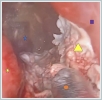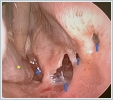|
|||
AbstractRhinolithiasis is a clinical disorder characterized by the deposition of calcified material in the nasal cavity around foreign items. Rhinoliths are frequently seen at the front of the nasal cavity and might be asymptomatic until they grow large enough to cause obstruction. Rhinoliths are typically characterized by chronic runny nose, headache, face discomfort, unpleasant nasal odor, halitosis, anosmia, nasal congestion, and periodic nosebleeds. This article describes the surgical removal of a bilateral massive rhinolith that mimicked an intranasal tumor and caused septal perforation by damaging the nasal cavity mucosa and septum cartilage.IntroductionRhinolithiasis is a clinical condition that occurs with the formation of calcified material around foreign bodies in the nasal cavity. It was first described in 1654 by Dr. Thomas Bartholin, and its first chemical analysis was made by Axmann in 1829. [1, 2] Rhinolith, usually seen in children, can occur around endogenous body tissues such as teeth, blood clots, de-squamated epithelium, bone fragments, or around exogenous foreign objects such as stones, insects, or wood. A chronic inflammatory reaction is triggered by the deposition of mineral salts such as calcium phosphate, calcium carbonate, and magnesium phosphate around the foreign body [2]. Rhinoliths are often located in the front of the nasal cavity, and sometimes, they can remain asymptomatic while they grow large enough to cause obstruction [2, 3]. Symptoms of rhinoliths usually include persistent runny nose, headache, facial pain, foul nasal odor, halitosis, anosmia, nasal congestion, and intermittent nosebleeds. Anterior rhinoscopic examination or imaging methods can make the diagnosis. Since most rhinoliths have a radiopaque appearance, they can be easily recognized and localized using conventional X-rays. Computed tomography (CT) may be necessary to determine the size and location of low-radiodense rhinoliths or before surgery. [4] This article presents a bilateral huge rhinolith, which was surgically removed under general anesthesia, mimicking an intranasal mass and causing septal perforation by destroying the nasal cavity mucosa and septum cartilage. Case ReportA 54-year-old female patient with mild mental retardation was brought to the Otorhinolaryngology outpatient clinic by her relatives with complaints of ear fullness and hearing loss. Otoscopic examination revealed that both tympanic membranes were retracted. A mass that completely filled the right nasal cavity was detected on examination of the nasal cavity with a rigid endoscope. It was observed that the mass covered with purulent secretion pushed the nasal septum entirely to the left, obliterating it to a level that did not allow the rigid endoscope to pass through the left nasal cavity. When examined from the oropharynx to the nasopharynx using a 70[o] angled rigid endoscope, it was determined that the mass filled the nasopharynx. It was learned that the patient, who had no known history of trauma or nasal surgery, could not breathe comfortably through her nose since she was a child. Her relatives reported that she had a foul-smelling, excessive runny nose, nasal congestion, cough, and a habit of constantly clearing her throat and wiping her nose for a long time. The patient, who had never been to an otolaryngologist with these complaints before, was diagnosed with asthma in a center where she applied with complaints of shortness of breath and was started on medications, and she had been receiving asthma treatment for the last two years. The CT scan of the patient showed a mass and pansinusitis findings compatible with highly hyperintense rhinoliths obliterating almost the entire right nasal cavity and the posterior half of the left nasal cavity. It was determined that the nasal septum was pushed up to the left lateral nasal wall by the mass effect of the rhinolith on the right side (Figure 1).
While normal hearing threshold levels were obtained in the audiometric examination, tympanometry revealed a bilateral type C tympanogram. Endoscopic sinus surgery was planned under general anesthesia. The rhinolith in the right nasal cavity was removed piece by piece endoscopically. After removing the rhinolith, purulent secretion from the osteo-meatal complex was observed to drain into the nasal cavity. There was pressure atrophy in the middle and inferior turbinate and three perforated areas in the bone septum, the largest of which was 2x2 cm, and the others 1x1 cm. The nasal mucosa in contact with the rhinolith appeared extremely fragile and degenerated. The left nasal cavity could be visualized by making a hemitransfixion incision in the caudal septum mucosa and removing the anterior deviated cartilage parts. Endoscopically, the rhinolith in the left nasal cavity was removed piece by piece (Figure 2- 3).
The histopathology was reported as chronic necrotic inflammatory rhinolith. At the postoperative follow-up, it was observed that the patient's nose and ear complaints had improved, the infection findings in the nasal mucosa had disappeared, the eardrums appeared normal, the pressure values had returned to normal in the tympanometric examination (Tympanogram Type A), but the septal perforations persisted (Figure 4).
The patient was scheduled for surgery to repair the septum perforation. It was learned that they stopped taking their asthma medications because their complaints of shortness of breath had resolved. DiscussionIn our article, we presented a case of complicated rhinolith perforating the nasal septal mucosa and cartilage, which we thought occurred long ago in the nose. The pathogenesis of rhinoliths is unclear, but several factors are thought to play a role in rhinolith formation. These include foreign bodies trapped in the nasal cavity, acute and chronic inflammation, obstruction and stagnation of nasal secretions, and precipitation of mineral salts. A foreign body in the nasal cavity hardens with the accumulation of elements such as iron, aluminum, calcium, and magnesium around it due to a chronic inflammatory response, causing rhinolith formation [5,6]. An extended period is usually required for rhinoliths to form. The fact that the rhinolith in our patient reached a size that filled the bilateral nasal cavities and even the nasopharynx suggested that it was due to the clinical condition of mild mental retardation. Rhinoliths are usually unilateral and single [7]. Patients generally present with complaints such as nasal congestion, unilateral rhinorrhea, head and facial pain, toothache, foul-smelling nasal discharge, bad breath, anosmia, and recurrent nosebleeds. Some cases are asymptomatic and found incidentally [2,8]. Due to the generally inadequate self-care of mentally disabled patients, their complaints of foul-smelling nasal discharge are ignored by their relatives and caregivers. In our case, although there were similar complaints, the patient and her relatives were not disturbed by the situation and did not visit a doctor until the complaint of ear-related congestion occurred. Sinusitis, septal deviation, and mucosal thickening are the most common nasal pathologies associated with rhinolith [7]. Other reported complications include septal perforation, frontal osteomyelitis, and, which are rarer and more vital, epidural abscess formation [8,9]. In our patient, the rhinolith on the right side formed and grew, deviated, and then perforated the nasal septum and continued to grow on that side by engaging the left nasal cavity. If it is not diagnosed, it could continue to grow and cause more severe complications. The differential diagnosis of rhinoliths includes nasal polyps, calcified angiofibroma, ossifying fibromas, granulomatous disease, fungal ball, nasal actinomycosis, ectopic tooth, osteoma, chondrosarcoma, osteosarcoma, and sino-nasal malignancies [10-13.] No fungus was found in the histopathological examination of the foreign bodies removed from our patient. While endoscopic nasal cavity examination is generally sufficient for diagnosis, since many diseases can be confused in the differential diagnosis, it would be appropriate to perform paranasal CT on patients to guide treatment planning and reduce the risk of complications that may occur during the possible surgical procedure. As in our patient, CT helps the ENT physician determine the rhinolith's location, size, and extent. It also allows us to evaluate the size of the rhinolith and the presence of additional paranasal diseases. Treatment of rhinolith is surgical removal, usually done endoscopically under general anesthesia. The endoscopic approach is usually sufficient; lateral rhinotomy is rarely required. The surgical approach varies depending on the location, size, and presence of complications of the rhinolith. In our case, the patient was reformed to health by endoscopic removal of the rhinolith and sinus surgery. ConclusionRhinolith is a rare clinical entity that can cause progressive destruction in the nasal cavity over time if it is not diagnosed. Although it is rare, when evaluating mentally disabled patients, especially those with long-term foul-smelling nasal discharge and nasal congestion, it should be approached with higher suspicion and imaging methods should be added in light of the patient's history and physical examination findings. We emphasize the importance of evaluating patients' mental state and social environment. We especially recommend that family physicians who follow up with elderly patients who are unable to care for themselves, who have dementia or who are mentally disabled, during routine health screenings, or professional healthcare professionals who serve the institutions where the patient lives question them more carefully in terms of the complaints listed above. In cases of clinical suspicion, referral to an otorhinolaryngologist is essential for early diagnosis and prevention of complications. References
|
|||
| Keywords : Burun tıkanıklığı , endoskopik burun cerrahisi; rinolitiyazis , septal perforasyon , | |||
|






